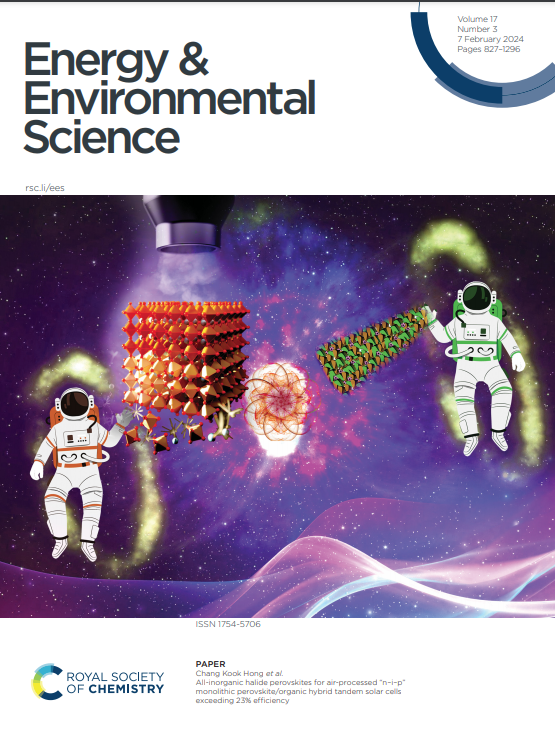Decoupling Electrode Kinetics to Elucidate Reaction Mechanisms in Alkaline Water Electrolysis
IF 30.8
1区 材料科学
Q1 CHEMISTRY, MULTIDISCIPLINARY
引用次数: 0
Abstract
Alkaline water electrolysis (AWE) presents key advantages, including reduced material costs, enhanced operational stability, and compatibility with non-precious metal catalysts, positioning it as a scalable route for hydrogen production. In this study, we introduce a minimally invasive single-cell configuration incorporating a reference electrode via diaphragm extension to form an internal ion channel. This setup, combined with an interfaced potentiostat and auxiliary electrometer, enables real-time, independent monitoring of anode and cathode behavior, offering high-resolution electrochemical diagnostics. Contrary to conventional assumptions that hydrogen evolution reaction (HER) is kinetically more favorable than oxygen evolution reaction, we demonstrate that HER is significantly more sluggish in practical nickel-based AWE systems. This observation is supported by both experimental data and voltage breakdown modeling. Arrhenius-type analysis reveals that localized electric fields induced by catalysts shift the reaction kinetics from classical Butler–Volmer behavior toward a Marcus-like regime, where interfacial molecular dynamics and bimolecular charge transfer dominate. We propose a semi-empirical model and a surficial reaction mechanism to describe these dynamics. This work underscores the critical need for cathode innovation and provides a rational framework for designing advanced catalysts and electrode architectures to optimize AWE performance.解耦电极动力学研究碱水电解反应机理
碱性水电解(AWE)具有关键优势,包括降低材料成本、增强操作稳定性以及与非贵金属催化剂的兼容性,使其成为可扩展的制氢途径。在这项研究中,我们引入了一种微创单细胞结构,其中包括一个参考电极,通过隔膜延伸形成内部离子通道。该装置与接口恒电位器和辅助静电计相结合,可以实时、独立地监测阳极和阴极的行为,提供高分辨率的电化学诊断。与传统的析氢反应(HER)在动力学上比析氧反应更有利的假设相反,我们证明了她在实际的镍基AWE系统中明显更缓慢。这一观察结果得到了实验数据和电压击穿模型的支持。Arrhenius-type分析表明,催化剂诱导的局域电场将反应动力学从经典的Butler-Volmer行为转变为marcus -类机制,其中界面分子动力学和双分子电荷转移占主导地位。我们提出了一个半经验模型和表面反应机制来描述这些动力学。这项工作强调了阴极创新的迫切需要,并为设计先进的催化剂和电极结构以优化AWE性能提供了合理的框架。
本文章由计算机程序翻译,如有差异,请以英文原文为准。
求助全文
约1分钟内获得全文
求助全文
来源期刊

Energy & Environmental Science
化学-工程:化工
CiteScore
50.50
自引率
2.20%
发文量
349
审稿时长
2.2 months
期刊介绍:
Energy & Environmental Science, a peer-reviewed scientific journal, publishes original research and review articles covering interdisciplinary topics in the (bio)chemical and (bio)physical sciences, as well as chemical engineering disciplines. Published monthly by the Royal Society of Chemistry (RSC), a not-for-profit publisher, Energy & Environmental Science is recognized as a leading journal. It boasts an impressive impact factor of 8.500 as of 2009, ranking 8th among 140 journals in the category "Chemistry, Multidisciplinary," second among 71 journals in "Energy & Fuels," second among 128 journals in "Engineering, Chemical," and first among 181 scientific journals in "Environmental Sciences."
Energy & Environmental Science publishes various types of articles, including Research Papers (original scientific work), Review Articles, Perspectives, and Minireviews (feature review-type articles of broad interest), Communications (original scientific work of an urgent nature), Opinions (personal, often speculative viewpoints or hypotheses on current topics), and Analysis Articles (in-depth examination of energy-related issues).
 求助内容:
求助内容: 应助结果提醒方式:
应助结果提醒方式:


